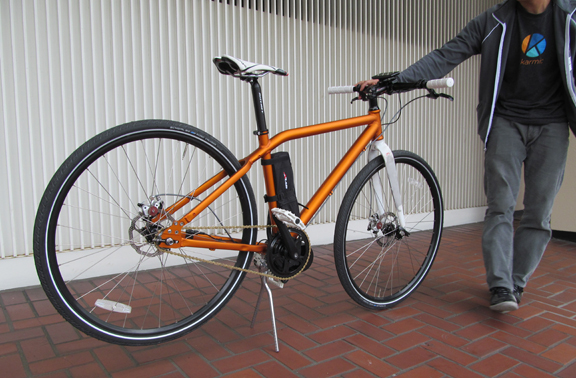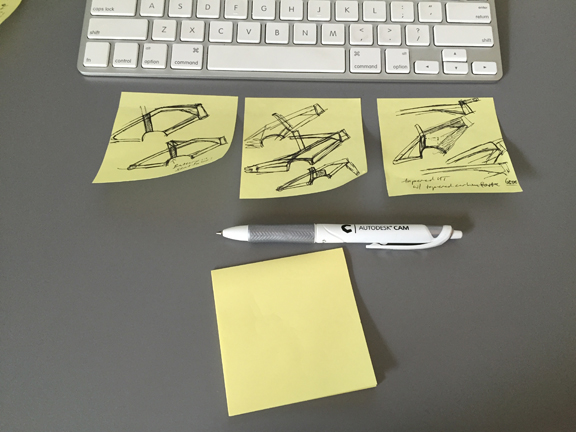
A prototype electronic bike from Karmic Bikes, designed in Autodesk Fusion 360 software.
Latest News
February 17, 2015
 A prototype electronic bike from Karmic Bikes, designed in Autodesk Fusion 360 software.
A prototype electronic bike from Karmic Bikes, designed in Autodesk Fusion 360 software. Karmic Bikes founder Hong Quan’s hand-drawn sketches for early concepts.
Karmic Bikes founder Hong Quan’s hand-drawn sketches for early concepts.Some people collects garden gnomes and Star Trek figurines. Hong Quan collects bikes. At last count, he has 15.
“I’ve been a cyclist for nearly two decades now, started off when I was in college as part of a biking team,” he said. “I’ve probably owned and ridden more than 100 bikes during that time.”
At age seven, Hong inherited his sister’s bike, a white-colored Schwinn. “That bike meant a lot to me,” he said. It meant the freedom to travel beyond a two-block radius from his home.
Hong, an immigrant from Vietnam who once worked on Wall Street, seeks to develop and market an electric bike that he said would “give you that same sense of exhilaration and joy.” That experience eludes most ebikes in the market today because, Hong observed, “They get too focused on the specs—range, power, distance. I love numbers as a bike nerd, and I do geek out on all the mechanical details, but when I’m riding, I don’t care about these numbers.” A great bike, he said, makes you forget you’re riding it, because it feels more like flying.
Hong is setting up shop under the name Karmic Bikes in Palo Alto, California, a city that has a $25 million bike boulevards program. Launching a business in the Bay Area, one of the most expensive places to live and work in the U.S., is not for the faint-hearted, but at least Hong’s design software comes free of charge.
Free Software for Startups
As a startup, Karmic Bikes qualifies to receive free licenses of Autodesk Fusion 360, the cloud-hosted software with mechanical CAD (some of the technology previously marketed as Inventor Fusion) and workgroup-level data management functions.
“We only have limited capacity for machine shop. Building and digitally prototyping things in 3D is whole lot cheaper than building physical prototypes in the shop,” Hong said. By his own admission, Hong is “the least technical person” in the team. He said, “even I can learn the software.”
The cloud-hosted platform (which uses a lightweight client to operate the CAD program) makes it easy for Hong and his California-based team to share ideas and collaborate with their manufacturing partner, based in Taiwan. Hong usually conducts these meetings over a Comcast cable internet connection with no hiccups.
“Since it’s online, I can actually make a change from my end, and it’s reflected right away overseas in a browser,” Hong remarked. “Sometimes they make changes because the design is difficult to manufacture, and we see them right away, so we can approve or reject them. It’s as if we have the people from Taiwan right there in our room.”
The Driving Force
If someone asks what is the core technology of Karmic Bikes, Hong would promptly answer, “It’s our patented battery.”
The electric battery is designed by Neal Saiki, a former NASA aerodynamic researcher. Neal went on to found Zero Motorcycles and NTS Works. In a sense, the battery used by Karmic Bikes is a direct descendent of the one that powers Zero Motorcycles.
Most battery packs, including those typically used in electric cars, are permanently welded together, Hong explained. “So if anything happens to one cell, the whole pack goes bad. We use high quality 18650 cells from Samsung. In our pack, the cells are held together in a new way. We can detect any failed cells and remove them without affecting the whole pack,” he said.
Eventually, when the battery cells start to lose charge retention, Karmic plans to take them back and recycle them in lower-powered applications.
The 90-Day Design Challenge
For the last decade since he parted ways with Wall Street traders, Hong had been circulating in the Bay Area’s startup community. Six years ago, Hong launched a project to build a car, but the failure to engage potential consumers early, he admitted, resulted in producing “something nobody really wanted.” He’s taking this lesson to heart.
In Karmic Bikes’ current prototype, the battery is external, easily removable from the frame when parked. Hong and his team plan to invite concept ideas for the battery pack’s outer case in a 90-day design challenge. (For details about the challenge, visit Karmic Bikes’ blog here.)
“We think there’s a market for electric bicycles. We want to design an ebike for everyone,” he said. “With a design challenge, we can share our vision and make sure we give people the features they want. Perhaps even more important, we can remove features they don’t want to keep the bike pure and simple.”
Hong thinks the ability to come up with customized features that reflect your personality—a battery case designed by you—will set Karmic bikes apart from the others you may have owned or ridden. The mass-customization option—or what Hong calls “the hack-ability factor”—is calculated to build a personal connection between you and your two-wheel transport. (DE plans to follow the design challenge throughout its 90 days and report on the entries.)
Autodesk is inviting the Autodesk Fusion community to participate in the 90-day challenge. For more, read the company’s post here.
The Way We Move Around the World
Those familiar with Asia’s Buddhist concepts would instantly recognize the metaphorical connection between the karmic cycle (often simply expressed as “what goes around comes around”) and the bicycle. Hong believes “What you contribute to the world is what you get back.” His career milestones, he reflected, are the direct consequences of something good he did for someone. He wants the idea of Karma to be intrinsic to the company’s mission.
Karmic’s electric bike won’t let the rider remain idle. “You have to pedal, and the bike’s battery assists you,” Hong clarified. “Bikes transform people and communities. They help you get fit, see a different side of the city—better than the view from inside a car.” Hong doesn’t think it’s idealistic to imagine that a better commute and a better outlook on life would lead to a better world.
Karmic has built several functional prototype units. They’re being put to test in the mountainous terrains of Santa Cruz, California.
“We’re not making things that would only last two to three years,” Hong said. “We’re making bikes that would hopefully last ten years.” The Karmic bikes might be passed along to someone else, like Hong’s own first bike.
Note: Karmic Bikes it not associated with Good Karma Bikes (http://www.goodkarmabikes.org/), a California-based nonprofit.
Subscribe to our FREE magazine, FREE email newsletters or both!
Latest News
About the Author
Kenneth Wong is Digital Engineering’s resident blogger and senior editor. Email him at [email protected] or share your thoughts on this article at digitaleng.news/facebook.
Follow DE





